Following the latest Federal Reserve meeting, there was a massive surge in media headlines stating “stagflation.” The media’s stagflation panic is unsurprising as it elicits memories of the late 1970s during the Arab oil embargo. Of course, a “stagflation” is excellent fodder for clicks and views as it scares the “bejeebers” out of people.
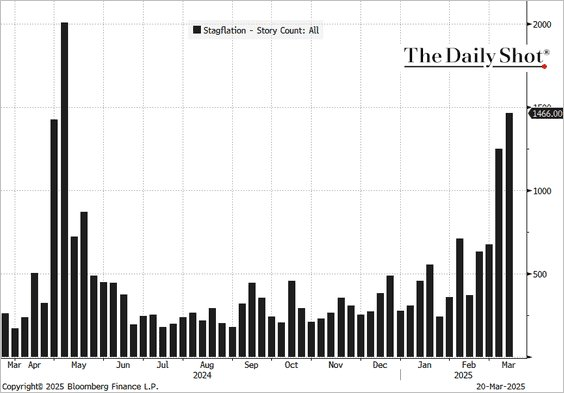
Over the last few weeks, the term “economic stagflation,” or just stagflation, has buzzed in the financial markets and media. For example, here is a short list of headlines about stagflation following the recent Fed meeting.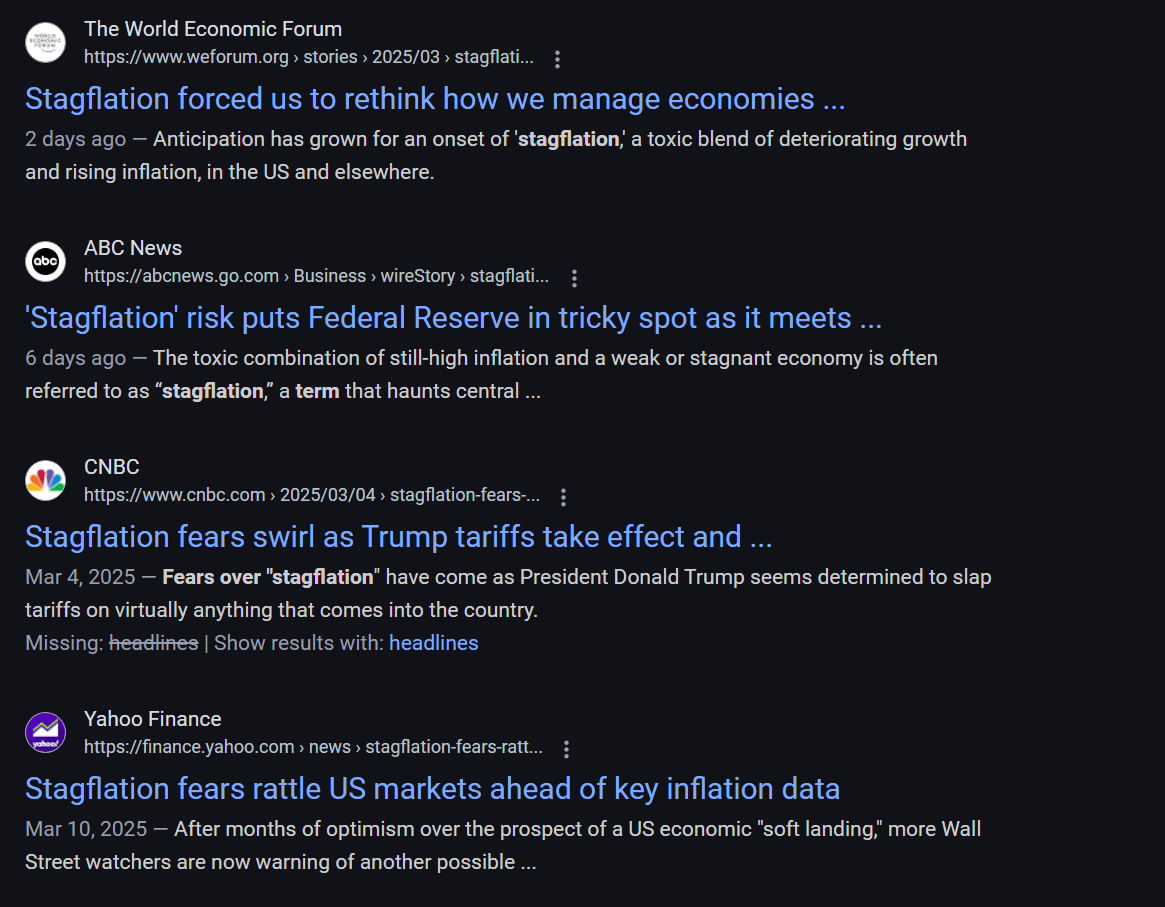
The problem is that economic “stagflation” is a complex economic phenomenon with significant implications for investors and the broader economy. As Taylor Sohns recently noted:
“It’s a bit like having a skunk in your backyard – an unpleasant situation that’s hard to manage.”
However, understanding why the media’s stagflation panic is incorrect is because they are using the wrong definition. Stagflation is NOT just weak economic growth with high inflation. The precise definition is: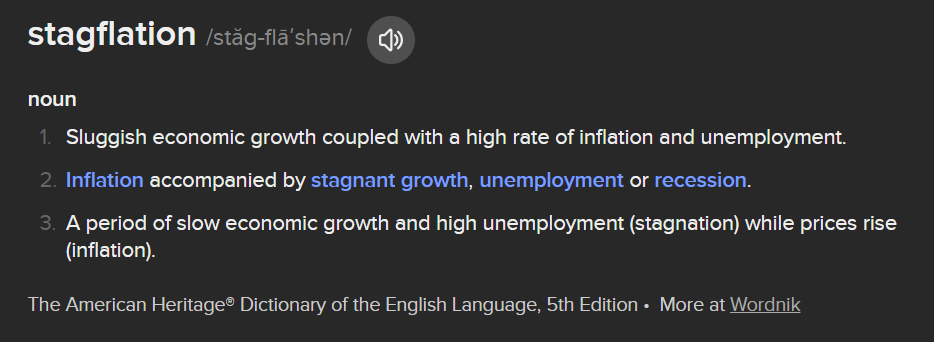
Economic stagflation is a rare economic phenomenon that is difficult for policymakers to handle as attempting to correct one issue tends to exacerbate the others.
To better understand the “stagflation panic,” we need to review the historical data and compare it to the actual definition of stagflation.
The Stagflation Of The 70s
To further confirm our definition of inflation, I asked ChatGPT why stagflation occurred in the 1970s.
“The stagflation of the late 1970s was one of the most challenging economic periods in U.S. history, marked by the unusual combination of high inflation, high unemployment, and slow economic growth. Unlike typical recessions where inflation and unemployment move in opposite directions, stagflation presented a unique challenge.”
Once again, the definition is high inflation and unemployment combined with slow economic growth. Likewise, today’s media stagflation panic lacks observation. The chart below presents inflation, real GDP, and the unemployment rate from 1960 to the present.
While the 70s did experience a sharp rise in inflation, much of that was due to strong economic growth rates nearing 15% annually. If you have vigorous economic activity, accompanied by rising wages, as in the 70s, prices will rise as demand outstrips supply, and companies can increase prices (Supply versus demand).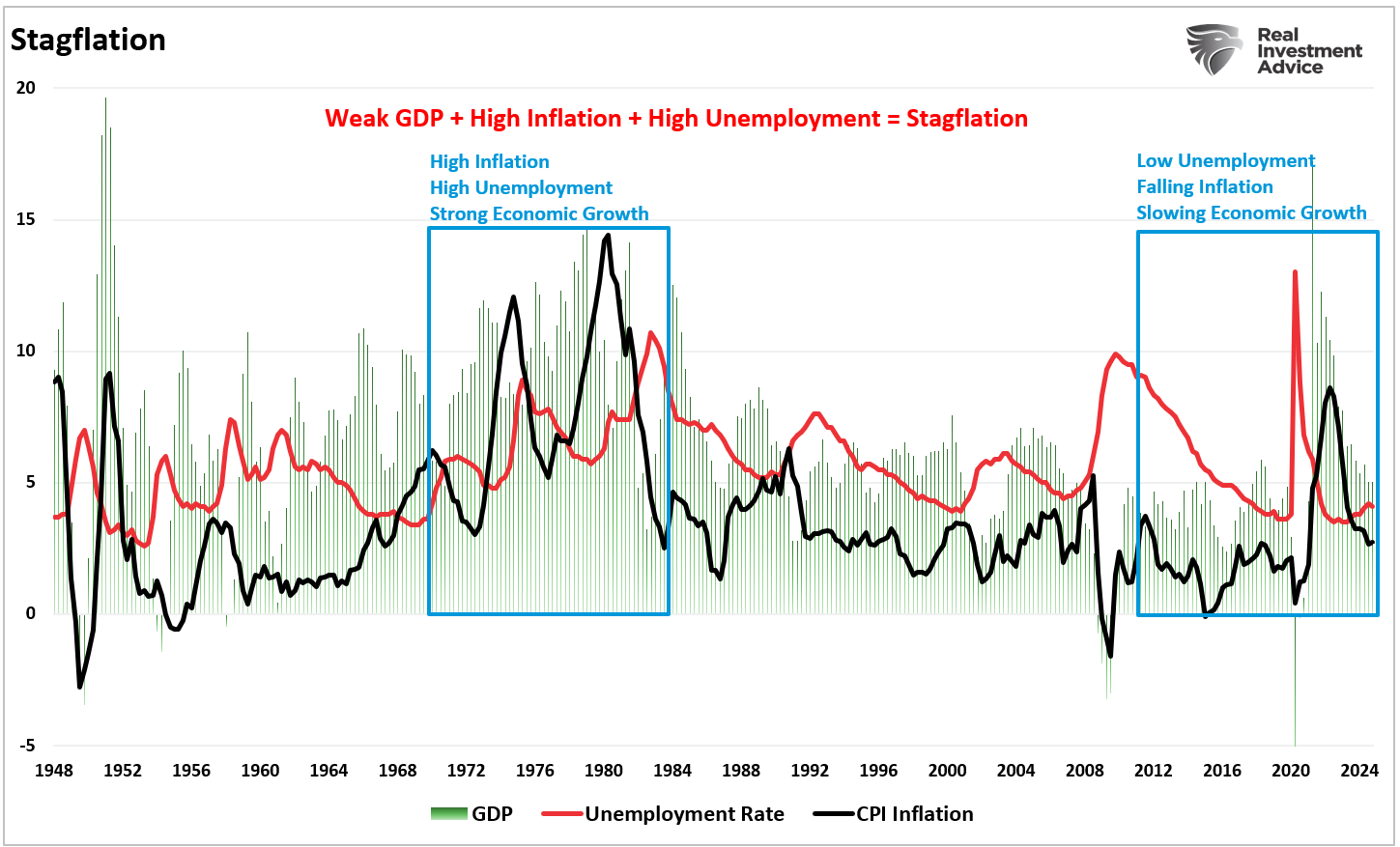
The inflation spikes in the 1970s were a function of several issues, starting with the 1973 OPEC oil embargo. That embargo sent oil prices soaring after the U.S. supported Israel in the Yom Kippur War. Then, in 1979, another crisis hit when the Iranian Revolution disrupted oil supplies, further driving up prices. Since oil is fundamental to transportation, manufacturing, and energy, the spikes in oil prices led to an inflationary surge.
However, while those two events created economic uncertainty, the artificial imbalance in the supply of a commodity (oil) and consumption needs (demand) created a short period of higher prices, a decline in economic activity, and increased unemployment. By looking at historical data, we can visualize the very short, artificially generated periods of stagflation.
The problem with today’s stagflation discussion is that there are no defined inflation, unemployment, or economic growth levels. At what level is inflation or unemployment too high, or when does economic growth become too slow? As such, the discussion of stagflation becomes very loose. However, we do know from history there are levels when things begin to break economically.
Using the data in the chart above, the historical averages are:
- Inflation: 3.76%
- Unemployment: 5.88%
- Real GDP: 3.03%
Historically, when inflation is above 5%, unemployment rises above 8%, and economic growth slows below 1%, recessionary onsets follow. The following composite index shows the only two “stagflationary” events in our current history.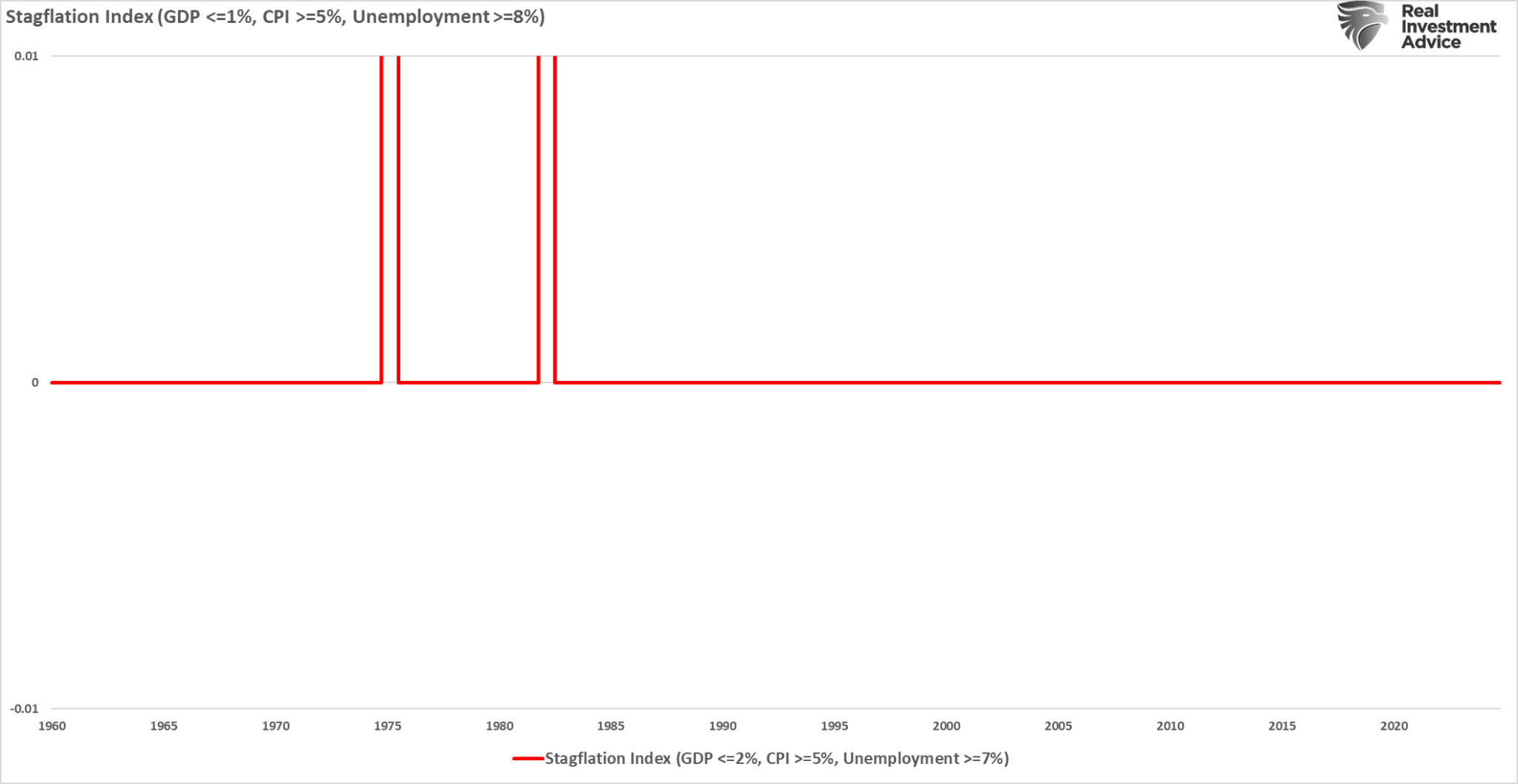
The current data suggests the media’s “stagflationary panic” is misplaced and imprecise.
Stagflation Panic Or A Misleading Narrative
During the only two previous bouts of stagflation, the Federal Reserve’s monetary policy failed to address rising prices. The Fed kept interest rates low and expanded the money supply, exacerbating inflation. Meanwhile, labor unions, which were very strong then, secured cost-of-living wage increases, leading to a wage-price spiral. Rising wages pushed prices even higher.
Ultimately, Federal Reserve Chairman Paul Volcker took aggressive action in the early 1980s. Volker sharply increased interest rates to induce an economic recession, which curbed inflation. Given that inflation is a function of economic activity (supply and demand), the actions were logical, resulting in economic stability.
Crucially, it can not be stressed enough that the issues with stagflation in the 70s were very dependent on singular issues. The question is, does the risk of stagflation exist currently? That answer is most likely “no.”
First, the Federal Reserve is acting appropriately by not drastically cutting interest rates. While the financial markets may not like Jerome Powell keeping the Fed funds rates elevated, it is the appropriate response to the current economic environment. The Fed’s goal is to slow economic activity by increasing borrowing costs, which will reduce consumer demand and bring down inflationary pressures. The “hat trick,” if the Federal Reserve can pull it off, is to not push the economy into a recession that leads to a surge in unemployment. So far, they have been successful in that process.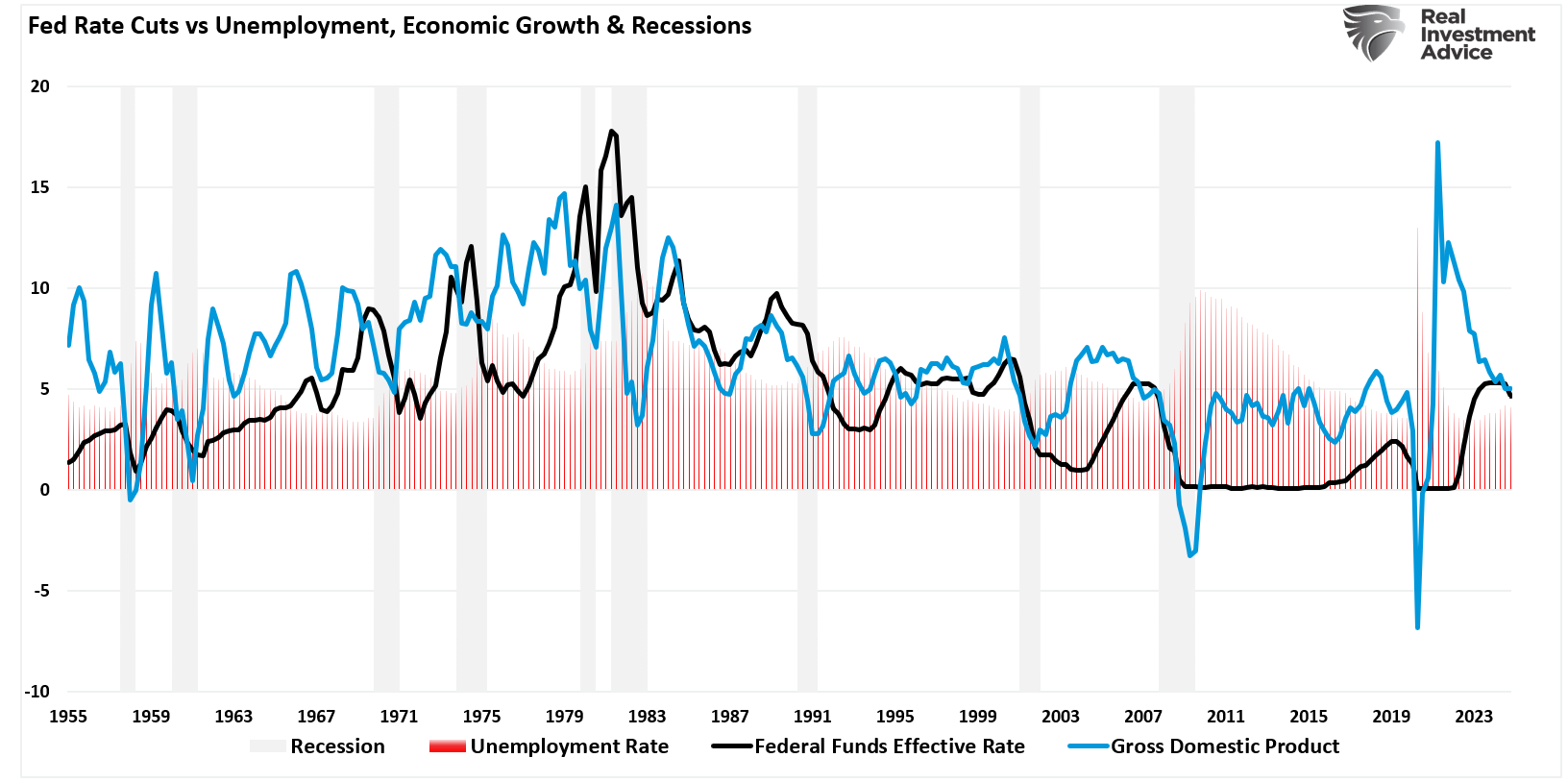
Again, stagflation is defined as high inflation, unemployment, and slow economic growth. I keep hammering this definition because it is critical to understanding whether the risk of stagflation is real and what investors should expect next. The chart above used nominal GDP to show the economy’s strength in the late 70s despite the inflation issues. However, most analysts use inflation-adjusted GDP when discussing stagflation, and we will use the same. The revised chart is below. Again, economic growth is returning to normal, unemployment remains historically low, and inflation is slowing with economic activity, as it should. There is currently no evidence to support the “stagflation panic.”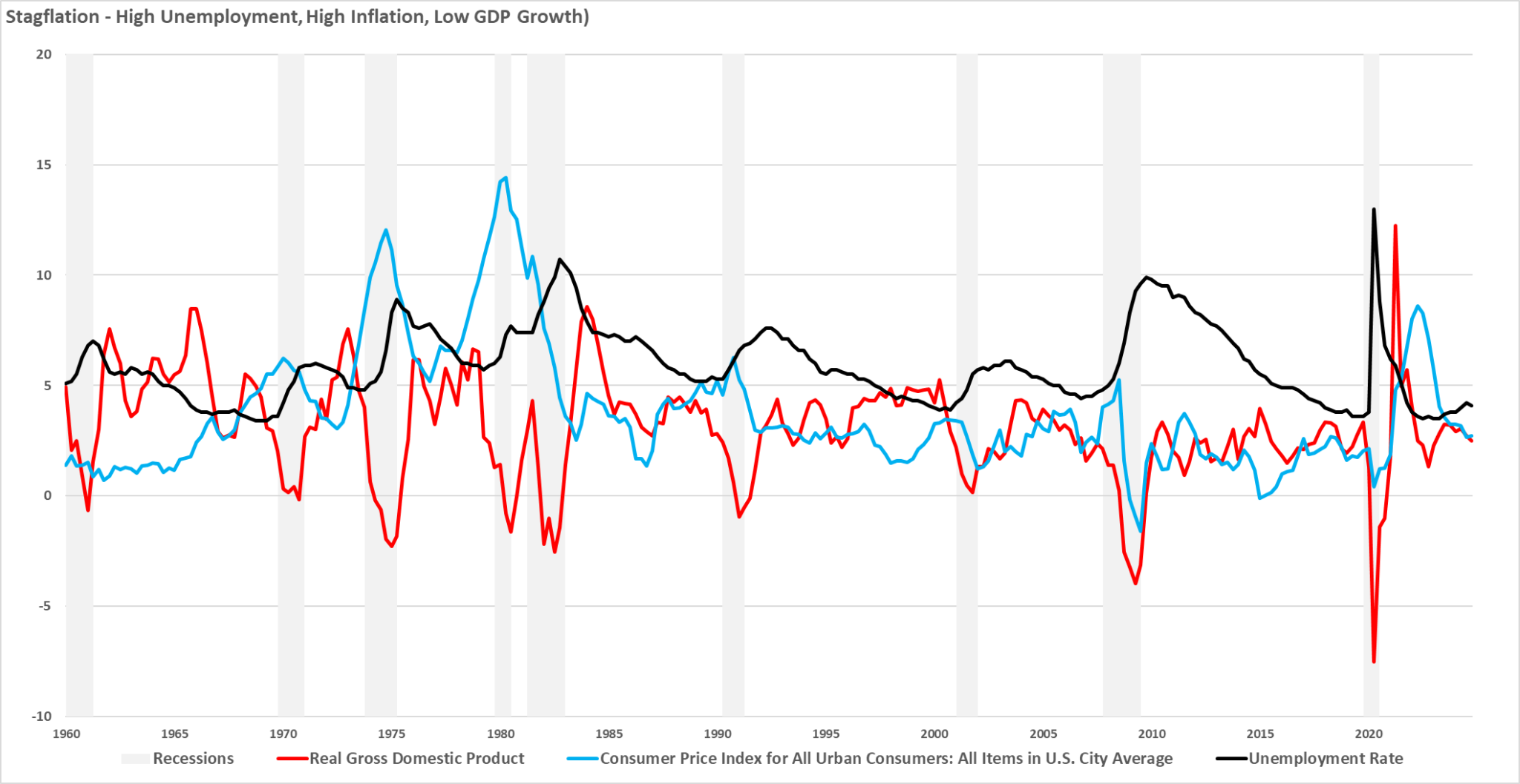
Most crucially, there is no “event” that causes a massive imbalance between supply and demand in the economy. It is quite the opposite, as supply chains are functioning, the consumer is slowing, and inventories were increased to front-run the risk of tariffs. The increased supply of inventories is historically deflationary, as producers have to cut prices to reduce that supply.
Could that change? Certainly. But that would require another event like an economic shutdown that significantly disrupts the economy. The impact of tariffs will not cause that shift.
Conclusion
For investors, the recent wave of “stagflation panic” headlines should be viewed with a healthy dose of skepticism. As we’ve seen, the current economic conditions—moderating inflation, historically low unemployment, and steady (if slower) economic growth—do not align with the true definition of stagflation. The media’s tendency to sensationalize short-term market movements often oversimplifies complex economic dynamics, leading to emotional reactions and misinformed decisions.
This is not the time to panic—it’s a time to stay disciplined. Investors should use this environment to assess portfolio risk, rebalance if necessary, and ensure diversification across asset classes and sectors. Avoid making major shifts based on media narratives that aren’t supported by data. Instead, focus on quality investments, strong balance sheets, and businesses with pricing power, which tend to hold up well in slower-growth environments.
If anything, this is a reminder that economic cycles fluctuate, and volatility is part of investing. Staying informed, patient, and focused on fundamentals will serve investors far better than chasing headlines. The current moment calls not for fear, but for measured optimism and strategic positioning.
